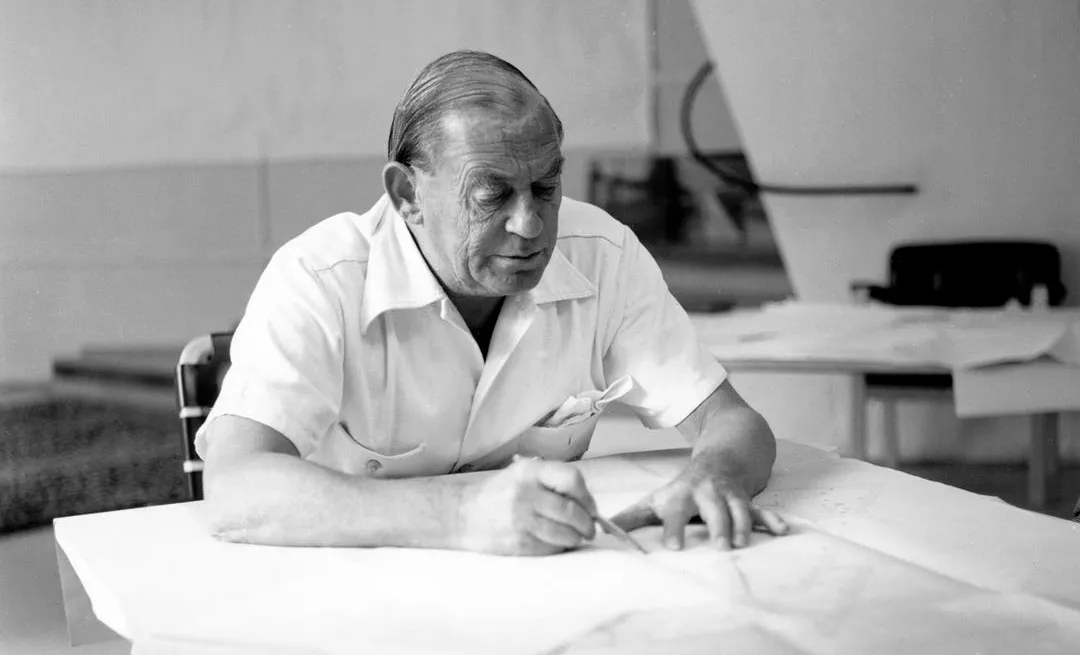“Our buildings should not merely meet one or two aesthetic norms; they should be placed in the landscape in a natural way, in harmony with its general contours.” Alvar Aalto 1925
The Finnish architect Alvar Aalto (1898–1976) approached the landscape from the perspective of topography, always taking the specific character of the site as his starting point. He designed the areas surrounding his buildings as extensions of their interiors.

Sketch for the Shiraz Art Museum (1967-70), perspective, Iran. Not realized. Original drawing Alvar Aalto Foundation.
The exhibition at Niavaran Cultural Center, Tehran, focuses on themes such as orientation and contours, nature and the use of the bedrock, vegetation and water features, as well as on Aalto’s way of dealing with enclosed gardens and terraces. In 1969–70, after his visit in Iran, Aalto designed a new Art Museum for Shiraz on top of a small hill set in a green plain at the foot of the Zagros mountains north of the city.
The exhibition builds a bridge between the main aspects of Aalto’s landscape thinking and the design for the unrealized Shiraz Art Museum. It includes some 40 archive photographs from the Alvar Aalto Foundation’s collections. The curator of the exhibition is the art historian Teija Isohauta. “Aalto accentuated the naturalness of the surrounding landscape and vegetation, the way that the building was able to grow old in peace – to become a part of nature. Aalto also made copious use of water motifs in his architecture, something not found in the Finnish architecture tradition. In all his internationalism Aalto was a “son of the forest”, who understood the world of sound that water brings with it, and that babbling water adds a living element to the urban environment,” says Isohauta.
Ambassador of Finland to Iran, Keijo Norvanto: “Aalto is highly respected among Iranians, but the ideas behind Aalto’s design work and his in-depth knowledge of landscape architecture are less well-known. In Iran professionals in the field express very similar viewpoints when designing buildings in the way they take account of the relationship with nature and the environment, in a country where things are being built at an astonishing rate. We particularly expect young students and architects, artists and designers at the start of their careers to visit the exhibition. A show of this calibre will spark an interest in collaboration between Iranian and Finnish experts. For the exhibition’s supplementary programme we are arranging screenings of Aalto documentary films at the Argo Factory gallery in Tehran. When Aalto visited Iran, besides Shiraz Art Museum, he was also asked to design Tehran’s main library. Neither project went forward at that time, but Aalto still inspires professionals today.”
The exhibition has been arranged in a collaboration between the Alvar Aalto Foundation, the Embassy of Finland in Tehran and Niavaran Cultural Center.

Alvar Aalto and the boat “Nemo Propheta in Patria” in the shore of Muuratsalo Experimental House. Photo: Alvar Aalto Museum.
Alvar Aalto is known as one of Finland’s most international architects, who made an exceptionally wide-ranging and multifaceted career as an architect and designer. His oeuvre, which extends from the 1920s to the 1970s, is hallmarked by an integrated approach to design and takes in public buildings, private houses, areal planning, and furniture and glass design. Aalto’s architecture is characterized by freeform treatment of space, use of natural materials, and taking account of the surroundings in the design of each building, not forgetting user-centredness and functionality.
Aalto worked in close collaboration with his first wife, the architect Aino Aalto(1894–1949), and their designs from the 1920s to 40s reflect an interest in the new trends in international modernism and in issues involved in the development of residential living. Aalto married his second wife, the architect Elissa Aalto(1922–1994), in 1952, and the couple’s work was marked by the major public building projects of the 1950s to 70s, both in Finland and abroad. Read more about the architect and his personal history at the Alvar Aalto Foundation´s web site: Alvar Aalto and Alvar Aalto´s Life.
Further information of the exhibition:
Embassy of Finland in Tehran, Iran, Tel. +98 212 351 2000
The Landscape of Alvar Aalto
Niavaran Cultural Center, Gallery No. 1, July 11–30, 2021
Open Sat–Thurs 10:00–18:00 and Fri 14:00–18:00. Closed on July 21, 2021.
Address: Farhangsara Alley. Opposite Niavaran Park. N. Pasdaran Ave., Tehran, Iran
Startimage: Alvar Aalto (1898–1976) in his Studio in 1960´s. Photo Alvar Aalto Foundation.


